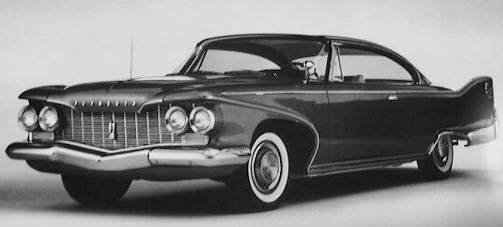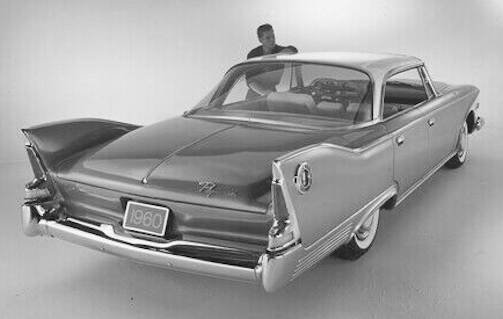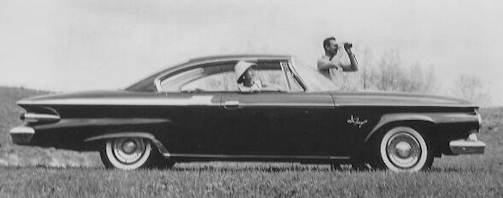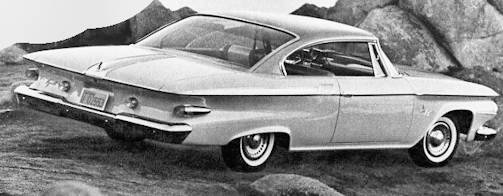Plymouth Fury 2nd generation
 |
|
|
Model years |
1960 to 1961 |
|
Body style |
4-door sedan |
|
Class |
Luxury car |
|
Engine |
225 cu in (3.69 L) slant-6 |
|
Transmission |
2-speed PowerFlite automatic |
|
Wheelbase |
118 in (2,997 mm) |
|
Length |
209.5 in (5,321 mm) |
|
Width |
80 in (2,032 mm) |
|
Height |
54.6 in (1,387 mm) |
The Plymouth Fury from the 1960s in the second generation, was built from 1960 to 1961
History
The Fury was still the top model of the brand and the most expensive version of the full-size models of Plymouth, which also included the Plymouth Savoy and the Belvedere. The three top-of-the-range series, like all full-size models of the Chrysler Group, were given a self-supporting unibody construction in 1960, which had been redesigned to support a subframe.As in previous years, there was once again different lengths wheelbases, with the models of Plymouth uniform (mm 2997; 118 inches) the shortest wheelbase used.

The body design of the 1960s vintage was redesigned, but followed in the roofline still the forward look of Virgil Exner. The front end of the Plymouth was independent. The Fury had twin headlights, which were covered by an extension of the fenders. From there, a sweeping bead passed into the car's flanks, which also included the front wheel cut-out. At the rear end, there were again high tail fins whose design housings are chrome plated corresponded to that of the previous year. Tailfins were removed for the 1961 model year. The design of the 1960s Fury vintage is considered unsuccessful.
The Plymouth Fury with its ability to carry six or seven people and a huge volume of luggage. There is no lack of all-round vision, however, and in wet weather variable-speed electrical wipers do a fine job of keeping the wind-screen clean.

The front compartment front seat is a one-piece bench Upholstered fabric woven from man-made fibres added upgraded upholstery full-length beltline trim;
Fury signatures behind the front wheel openings the seats with the inevitable limitations of its kind no lateral support can be provided, and the passenger must accept the driver's dictates concerning legroom but it is genuinely comfortable. Makes three people quite comfortable in spite of a high and broad hump over the gearbox and the rear compartment, which suffers much less from intrusion by the transmission cover A rear-seat passenger enjoys ample headroom and knee-room, can accommodate four people without much feeling of discomfort. The Plymouths was handling extremely stabile at all speeds.
A small glove box useless for stowing maps or anything else No pockets or other stowage or oddments are provided inside the still roomy body. Speedometer Instruments are simple, comprising uncalibrated indicators for fuel level and for engine heat, and a strip-type speedometer The heating and de-misting as standard equipment is powerful. Also fitted as standard is a push-button radio, and there is a separate speaker. extras such as backup lights and an electric clock.
An automatic transmission which is Known as the Torque-flite and incorporating a torque converter as well as three automatic gears, this Chrysler two- pedal transmission is one of the very best of its kind. From a row of five buttons (which are illuminated internally at night) the driver must press the Neutral one before starting the engine and will then normally press either Drive (forward) or Reverse button as required. Two other buttons serve merely to make extra engine braking available in 2nd or 1st ratios down steep hills, or to engage first gear for push-starting a car with a flat battery. when maximum acceleration is needed, and can be obtained by kick-down pressure on the accelerator pedal at 25 m.p.h. up to in excess of 105 m.p.h. with- out a trace of wheelspin
After just one year, the body in the front and rear area was redesigned. For model year 1961 disappeared the curved bead in the front fenders and the tail fins. The waistline of the car was now almost horizontal. The taillights were in free-standing tubes in the car flanks.
The Fury was offered in 1960 and 1961 respectively as a convertible, as a four-door sedan with fixed B-pillar and as a two- and four-door hardtop without B-pillar. The range of body versions was thus wider than that of the Savoy and the Belvedere.
The engine output changed from 1959. The standard engine in both years was a 3687 cc (225 cubic inch) version of the newly designed six-cylinder (Slant Six) with 145 SAE-PS. Optionally the first year for Chrysler's ram induction system, 1960 were two eight-cylinder V-engines with 5.2 and 5.9 litres displacement available, 1961 there was also a 6.3-liter V8 engine The 383 was rated at 330 hp (250 kW).
Of the three luxury-class series of the brand Plymouth sold the Fury, which was also the most expensive line, the worst. In the model year 1960 created about 54200 vehicles (more than 23000 less than the Savoy), in the model year 1961 there were only 38000 furies. The Polara, the sister model of the Dodge brand, however, was sold in both years even less often: in 1960 there were about 16,000 Polaras, 1961 only 14,000.

Technical
-
Engine upgrade options
V-8 317.6 cubic inch 260 horsepower four-barrel engine
V-8 360.8 cubic inch 305 horsepower four-barrel engine .
V-8 383 cubic inch 325 horsepower four-barrel engine
V-8 383 cubic inch 330 horsepower dual four-barrel engine
V-8 383 cubic inch 340 horsepower dual four. barrel engine
V-8 413.2 cubic inch 350 horsepower four-barrel engine
V-8 413.2 cubic inch 375 horsepower dual four-barrel engineOptions
Four-barrel carburetor
Ram induction package is included with all dual four-barrel V-8
Sure-Grip positive traction rear axle
Torqueflite automatic transmission
Dual exhausts
Crankcase vent system, (mandatory California)Some Standard or Options
Power brakes
Power steering
Air conditioning including heater
dual air conditioning with heater
Heater and defroster
Saf-T-Matic power door locks
Two-tone paint.
Six-Way power seat
Push button radio
Hi-fi radio
automatic record player
